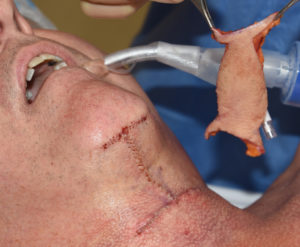Significant aging of the neck is most commonly treated by a neck lift, also known as a lower facelift. While earlier signs of neck sagging/fullness may be treated by liposuction and other more limited procedures, true neck wattles can only be treated by more traditional and aggressive approaches.
A lower facelift/necklift repositions the hanging neck skin back towards the ear and removes the excess tissue there. This requires incisions to be placed around the ears. Thus the tissue removed results in scars that are placed in relatively inconspicuous locations. This is a fundamental principle of facelift surgery. But men pose unique challenges in facelift surgery because of their often limited hair or short hairstyles around the ears. This makes it hard to hide the facelift scars and, as a result, may also make it difficult to get a good neck lift result.

The direct necklift is a tremendously powerful procedure for removing neck wattles. It is actually more effective than a traditional fuller neck lift/lower facelift because it removes the neck wattle directly. But it does so at the expense of neck scars and that is its major consideration. Fortunately the beard skin in older men (greater than age 65) heals very well. At this age the direct necklift offers a less invasive procedure with minimal recovery and avoids scars and potential hairline disruption around the ears.
Dr. Barry Eppley
Indianapolis, Indiana


